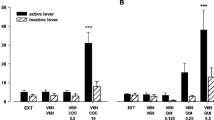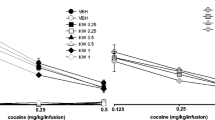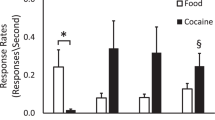Summary
(+)-AJ 76 is a stimulant dopamine (DA) antagonist, which has a putative preferential action at DA nerve terminal autoreceptors. Because it is both a mild stimulant and a DA antagonist, it has previously been suggested that (+)-AJ 76 might antagonize both the euphoria and craving associated with cocaine abuse and withdrawal, respectively. To evaluate this hypothesis further, (+)-AJ 76 was evaluated for its ability to affect cocaine-induced changes in regional brain energy metabolism. Using Sokoloff's 2-deoxyglucose autoradiographic technique, (+)-AJ 76 antagonized the stimulant effect of cocaine. Although classical DA antagonists are known to depress regional brain energy metabolism, (+)-AJ 76 by itself had no effect. It is concluded that the results are consistent with the previously stated hypothesis that (+)-AJ 76 might be useful as a pharmacotherapy for treatment of cocaine abuse.
Similar content being viewed by others
References
Blin J, Ray CA, Chase TN, Piercey MF (1991) Regional cerebral glucose metabolism compared in rodents and humans. Brain Res 568: 215–222
Bradberry CS, Roth RH (1989) Cocaine increases extracellular dopamine in rat nucleus accumbens and ventral tegmental area as shown by in vivo microdialysis. Neurosci Lett 103: 97–102
Broderick PA (1991) Cocaine on-line analysis of an accumbens amine neural basis for psychomotor behavior. Pharmacol Biochem Behav 40: 959–968
Broderick PA (1992a) Cocaine: co-localized effects of synaptic serotonin and dopamine in ventral tegmentum in a reinforcement paradigm. Pharmacol Biochem Behav 42: 889–898
Broderick PA (1992b) Distinguishing effects of cocaine, i.v. and s.c., on mesoaccumbens dopamine and serotonin release with chloral hydrate anesthesia. Pharmacol Biochem Behav 43: 929–937
Callahan PM, Piercey MF, Cunningham KA (1992) Effects of the putative dopamine autoreceptor antagonists AJ 76 and UH 232 on the discriminative stimulus properties of cocaine. Psychopharmacology 107: 73–77
Einhorn LC, Johnson PA, White FJ (1988) Electrophysiological effects of cocaine in the mesoaccumbens dopamine system: studies in the ventral tegmental area. J Neurosci 8: 100–112
Evenden JL, Ryan CN (1988) Behavioral responses to psychomotor stimulant drugs: localization in the central nervous system. Pharmacol Ther 36: 151–172
Goeders NE, Smith JE (1983) Cortical dopaminergic involvement in cocaine reinforcement. Science 221: 773–774
Henry DJ, Greene MA, White FJ (1989) Electrophysiological effects of cocaine in the mesoaccumbens dopamine system: repeated administration. J Pharmacol Exp Ther 251: 833–839
Hoffmann WE, Svensson K, Calahan P, Cunningham K, Mead B, Lum JT, Piercey MF (1991) Interactions between cocaine and the presumed preferential dopamine autoreceptor antagonists, (+)-AJ 76 and (+)-UH 232. Neurosci Abstr 17: 681
Jarvik ME (1990) The drug dilemma: manipulating the demand. Science 250: 387–392
Kleber HD, Gawin FH (1984) The spectrum of cocaine abuse and its treatment. J Clin Psychiatry 45: 18–23
London ED, Wilkerson G, Goldberg SR, Risner ME (1986) Effects of l-cocaine on local cerebral glucose utilization in the rat. Neurosci Lett 68: 73–78
McCulloch J, Savaki HE, Sokoloff L (1982) Distribution of effects of haloperidol on energy metabolism in the rat brain. Brain Res 243: 81–90
Pan H-T, Menacherry S, Justice JB Jr (1991) Differences in the pharmacokinetics of cocaine in naive and coaine experienced rats. J Neurochem 56: 1299–1306
Paxinos G, Watson C (1986) The rat brain in stereotaxic coordinates, 2nd edn. Academic Press
Phelan FT, Wechsler RT, Eng F, Piercey MF, Broderick PA (1992) AJ 76, a dopamine autoreceptor antagonist, modulates accumbens dopamine and serotonin in cocaine-induced psychostimulant behavior. Neurosci Abstr 18: 1456
Piercey MF, Ray CA (1988) Evidence from 2-DG autoradiography that phencyclidine's functional effects are mediated by specific PCP rather than sigma receptors. In: Domino E (ed) Sigma opiod/phencyclidine-like compounds as molecular probes in biology. NPP Press, Ann Arbor MI, pp 285–295
Piercey MF, Lum JT, Hoffmann WE, Carlsson A, Ljung E, Svensson K (1992) Antagonism of cocaine's pharmacological effects by the stimulant dopaminergic antagonists, (+)-AJ 76 and (+)-UH 232. Brain Res 588: 217–222
Piercey MF, Ray CA (1988) Dramatic stimulation of limbic and cortical structures via high affinity PCP receptors. Life Sci 143: 379–385
Piercey MF, Lum JT (1990) Electrophysiological effects of dopamine autoreceptor antagonists, (+)-AJ 76 and (+)-UH 232. Eur J Pharmacol 182: 219–226
Porrino LF, Domer FR, Crane AM, Sokoloff L (1988) Selective alterations in cerebral metabolism within the mesocorticolimbic dopaminergic system produced by acute cocaine administration in rats. Neuropsychopharmacology 1: 109–118
Richardson NR, Piercey MF, Svensson K, Collins RJ, Myers JE, Roberts DCS (1993) An assessment of the reinforcing and anti-cocaine effects of the preferential dopamine autoreceptor antagonist, (+)-AJ 76. Brain Res 619: 15–21
Ritz MC, Lamb RJ, Goldberg SR, Kuhar MJ (1987) Cocaine receptors on dopamine transporters are related to self-administration of cocaine. Science 237: 1219–1223
Sokoloff L, Reivich M, Kennedy C, Des Rosiers MH, Patlak CS, Pettigrew KD, Sakurada O, Shinohara M (1977) The [14C]deoxyglucose method for the measurement of local cerebral glucose utilization: theory, procedure and normal values in the conscious and anesthetized albino rat. J Neurochem 28: 897–916
Svensson K, Johansson AM, Magnusson T, Carlsson A (1986) (+)-AJ 76 and (+)-UH-232: central stimulants acting as preferential dopamine autoreceptor antagonists. Arch Pharmacol 334: 234–245
Waters N, Piercey MF, Carlsson A (1991) On the effects of the dopamine D3 receptor preferring antagonists (+)-AJ 76 and (+)-UH 232 on dopamine release and metabolism. Neurosci Abstr 17: 1352
Wise RA, Rompre PP (1989) Brain dopamine and reward. Ann Rev Psychol 40: 191–225
Author information
Authors and Affiliations
Rights and permissions
About this article
Cite this article
Casey, B.L., Ray, C.A. & Piercey, M.F. Antagonism of cocaine's stimulant effects on local cerebral glucose utilization by the preferential autoreceptor antagonist (+)-AJ 76. J. Neural Transmission 103, 277–285 (1996). https://doi.org/10.1007/BF01271239
Received:
Accepted:
Issue Date:
DOI: https://doi.org/10.1007/BF01271239




